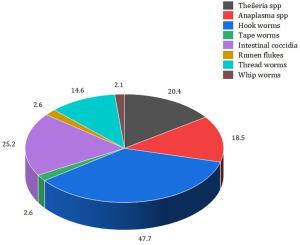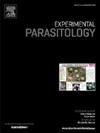环境因素对印度喀拉拉邦散养拴系山羊宿主与寄生虫相互作用模式的影响
IF 1.4
4区 医学
Q3 PARASITOLOGY
引用次数: 0
摘要
环境是寄生虫病流行病学三要素中最重要的一环,环境因素的任何变化都可能决定这些寄生虫不同生命周期阶段的动态发生和存在。本研究调查了主要生物气象和人口统计参数与山羊不同胃肠道寄生虫和血液寄生虫发病率之间的相关性。2022 年 7 月至 2023 年 6 月,在印度喀拉拉邦 Mannuthy 的教学兽医临床综合大楼进行了为期一年的调查,对 422 只山羊进行了寄生虫感染筛查。在记录天气参数(Tmax、Tmin、RH、THI 和日照时数)、空气质量参数[AQI、PM2.5 和 PM10]和人口统计参数(性别和年龄)的同时,还通过常规粪便样本检查和血涂片检查分别检测了山羊体内不同种类的胃肠道寄生虫和血液寄生虫的阳性率。根据感染的严重程度对感染等级进行排序。计算了生物气象参数的平均值和日变化,并对数据进行了统计分析,以找出宿主-寄生虫-环境相互作用模式中的相关关联。结果发现,寄生虫感染率很高,月度变化很大,感染高峰与气候相关。除湿度外,寄生虫的发病率与所有参数都呈负相关,这表明季风月份的寄生虫病更为严重。宿主-寄生虫相互作用动态的显著变化表明,有必要对每种特定寄生虫的生命周期进行详细探索,重点关注可能的环境有利和有抵抗力的生命周期阶段。未来的研究可以从生物气象学的角度进行设计,以便对山羊宿主-寄生虫-环境的相互作用有一个重要的了解,从而确保山羊养殖业的可持续发展。本文章由计算机程序翻译,如有差异,请以英文原文为准。

Effects of environmental factors on host-parasite interaction patterns in backyard-tethered goats of Kerala, India
The environment is the most important stratum in the epidemiological triad of a parasitic disease and any variations in the environmental factors may decide the dynamic occurrence and existence of different lifecycle stages of these parasites. The present study investigated the correlations between key biometeorological and demographical parameters with the incidence of different gastrointestinal parasites and hemoparasites among goats. Four hundred and thirty-two goats were screened for parasitic infection in a yearlong survey conducted from July 2022 to June 2023 in the Teaching Veterinary Clinical Complex, Mannuthy, Kerala, India. The weather parameters (Tmax, Tmin, RH, THI, and bright sunshine hours), air quality parameters [AQI, PM2.5, and PM10], and demographic parameters (gender and age) were recorded along with the test positivity of different categories of gastrointestinal parasites and hemoparasites in goats by routine fecal sample examination and blood smear examination, respectively. The infection level was ranked based on the severity of the infection. The mean and daily variations in biometeorological parameters were calculated and the data were statistically analyzed to figure out the pertinent correlations in host-parasite-environment interaction patterns. High levels of parasitic infections with significant month-wise variations and climate-correlated peak infection patterns were noticed. The incidence of parasites was negatively correlated to all parameters except humidity, indicating more severe parasitism during monsoon months. The significant variations in the host-parasite interaction dynamics point towards the need for detailed explorations concerning the lifecycle of each specific parasite with a focus on the possible environment-favourable and resistant lifecycle stages. Future studies may be designed from a biometeorological perspective to develop a crucial understanding of host-parasite-environment interactions in goats ensuring sustainable goat farming.
求助全文
通过发布文献求助,成功后即可免费获取论文全文。
去求助
来源期刊

Experimental parasitology
医学-寄生虫学
CiteScore
3.10
自引率
4.80%
发文量
160
审稿时长
3 months
期刊介绍:
Experimental Parasitology emphasizes modern approaches to parasitology, including molecular biology and immunology. The journal features original research papers on the physiological, metabolic, immunologic, biochemical, nutritional, and chemotherapeutic aspects of parasites and host-parasite relationships.
 求助内容:
求助内容: 应助结果提醒方式:
应助结果提醒方式:


